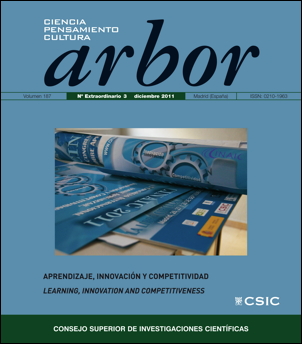Self-evaluation to chemistry laboratory sessions: introduction to self-learning
DOI:
https://doi.org/10.3989/arbor.2011.Extra-3n3156Keywords:
E-learning, Sakai, pre-lab questionnaires, assessment, self-learningAbstract
In this work a strategy to improve learning outcomes of laboratory sessions of a Chemistry subject of the Bachelor’s Degree in Rural and Agrifood Engineering is shown. In this experience the e-learning platform PoliformaT was used to propose timed pre-lab questionnaires to allow self-assessment of students before laboratory sessions, this allowed an increase in the preparation and the interest of the student on the performance of the laboratory session. The effectiveness of this strategy was established from the analysis of data collected during its application and also by means of an opinion call. It is noteworthy that these questionnaires have induced change of attitude among students, encouraging an active posture (and positive) towards the laboratory session.
Downloads
References
Burewicz, A. y Miranowicz, N. (2006): “Effectiveness of multimedia laboratory instruction”, Chemistry Education: Research and Practice, vol. 7, pp. 1-12. http://dx.doi.org/10.1039/b4rp90006e
Carnduff, J. y Reid, N. (2003): Enhancing undergraduate chemistry laboratories: pre-laboratory and post-laboratory exercises, Royal Society of Chemistry.
Dalgarno, B.; Bishop, A. G.; Adlong, W. y Bedgood, D. R. (2009): “Effectiveness of a virtual laboratory as a preparatory resource for distance education chemistry students”, Computers & Education, vol. 53, pp. 853-865. http://dx.doi.org/10.1016/j.compedu.2009.05.005
Fike, D. S.; Doyle, D. y Connelly, R. J. (2010): “On-line vs paper evaluations of fa culty: When less is just as good”, The Journal of Effective Teaching, vol. 2, pp. 42-54.
Jenkins, M. (2004): “Unfulfilled promise: Formative assessment using computer- aided assessment”, Learning and Teaching in Higher Education, vol. 1, pp. 67-80.
Johnstone, H. y Al-Shuaili, A. (2001): “Learning in the laboratory; some thoughts from the literature”, University Chemistry Education, vol. 5, pp. 42-51.
Limniou, M.; Papadopoulos, N. y Whitehead, C. (2009): “Integration of simulation into pre-laboratory chemicalcourse: Computer cluster versus WebCT”,Computers & Education, vol. 52, pp. 45-52. http://dx.doi.org/10.1016/j.compedu.2008.06.006
Llorens-Molina, J. A. (2009): “Design and assessment of an online prelab modelin general chemistry: A case study”, Journal of the Research Center for Educational Technology, vol. 4, pp. 15-31.
Masson, M. R. (2001): “Experience with a random questionnaire generator in the chemistry laboratory and for other continuous assessment”, University Chemistry Education, vol. 5, pp. 9-15.
McKelvy, G. M. (2008): “Preparing for the chemistry laboratory: An internet presentation and assessment tool”, University Chemistry Education, vol. 2, pp. 46-49.
Nicholls, B. S. (1999): “Pre-Laboratory support using dedicated software”, University Chemistry Education, vol. 3, pp. 22-27.
Reid, N. y Shah, I. (2007): “The role of laboratory work in university chemistry”, Chemistry Education Research and Practice, vol. 8, pp. 172-185. http://dx.doi.org/10.1039/b5rp90026c
Roffe, I. (2002): “E-learning: engagement, enhancement and execution”, Quality Assurance in Education, vol. 10, pp. 40-50. http://dx.doi.org/10.1108/09684880210416102
Schmid, S. y Yeung, A. (2008): “The influence of a pre-laboratory work module on student performance in the first year chemistry laboratory”, Research and Development in Higher Education, vol. 28, pp. 471-479.
Sierra, J.; Bosque, J.; García, A.; Blanc, R.; Del, M.; Gámiz, L. y Alés, F. (2009): “Aprendizaje de procesos analíticos mediante clases prácticas con laboratorios virtuales”, Enseñanza de las Ciencias, Número Extra VIII Congreso Internacional sobre Investigación en Didáctica de las Ciencias, Barcelona, pp. 2466-2470.
Tortajada-Genaro, L. A.; Noguera, P.; Atienza, J.; Herrero, M. A., García-Rupérez, J.; Sanchís, P.; Vidal, B.; Fenollosa, M. L.; Ribal, F. J.; Bes, M. A.; Blasco, E. y Muñoz, M. J. (2011): Auto-evaluación previa a las Prácticas mediante la Plataforma de e-Learning PoliformaT. Una experiencia multidisciplinar, Segunda Conferencia Internacional en Fomento e Innovación con Nuevas Tecnologías en la Docencia de la Ingeniería (FINTDI), en prensa.
Yang, Y. F. y Tsai, C. C. (2010): “Conceptions and approaches to learning through online peer assessment”, Learning and Instruction, vol. 20, pp. 72-83. http://dx.doi.org/10.1016/j.learninstruc.2009.01.003
Yeung, A.; Schmid, S. A.; George, A. V. y King, M. (2009): “Increasing students’ interest and motivation through effective design on online learning environments”, Proceedings of the Motivating Science Undergraduates, A. Hugman (Ed.), Sydney, pp. 132-138.
Downloads
Published
How to Cite
Issue
Section
License
Copyright (c) 2011 Consejo Superior de Investigaciones Científicas (CSIC)

This work is licensed under a Creative Commons Attribution 4.0 International License.
© CSIC. Manuscripts published in both the printed and online versions of this Journal are the property of Consejo Superior de Investigaciones Científicas, and quoting this source is a requirement for any partial or full reproduction.
All contents of this electronic edition, except where otherwise noted, are distributed under a “Creative Commons Attribution 4.0 International” (CC BY 4.0) License. You may read the basic information and the legal text of the license. The indication of the CC BY 4.0 License must be expressly stated in this way when necessary.
Self-archiving in repositories, personal webpages or similar, of any version other than the published by the Editor, is not allowed.














